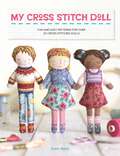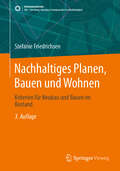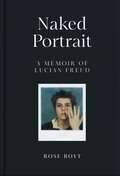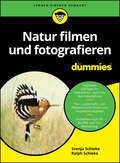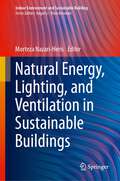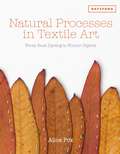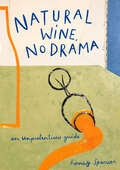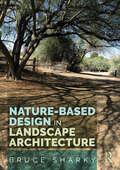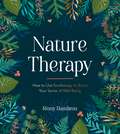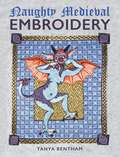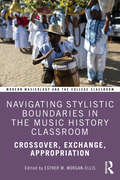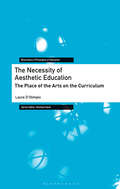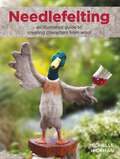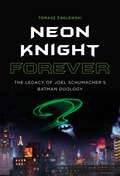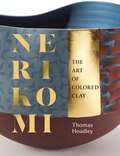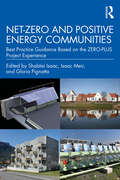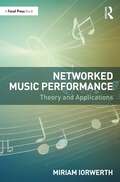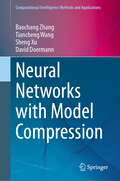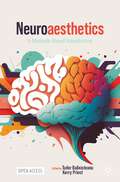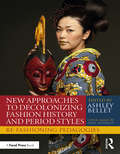- Table View
- List View
My Cross Stitch Doll: Fun and easy patterns for over 20 cross-stitched dolls
by Susan BatesCreate beautiful, embroidered dolls with easy cross stitch patterns and simple sewing techniques.First, choose your doll from one of the 20 delightful patterns included, then stitch your front and back panels. Once completed, place the two pieces right sides together and sew around the outline, leaving a gap for turning. Turn it right sides out, stuff, sew up the gap and hey presto - you've made a dolly! This simple process means you can make a beautiful handmade doll with the minimum of skill or experience, creating a treasured heirloom that, if cared for, will last for generations.The 20 doll patterns include a wide range of skin tones, hairstyles and clothing with the option to change any of the colours to suit your own tastes. Additional patterns at the back of the book give further options for alternative heads and garments so you can customise the patterns and make your own unique dolls. Stitch them for yourself as little sewing room pals, or create them as gifts for people you love - they can't fail but charm everyone who sees them.The smallest doll is 10.5cm wide x 21.2cm high (4¼in wide x 8½in high) and the largest is 11.6cm wide x 23.4cm high (4½in wide x 9¼in high). With full-colour charts for the cross stitch patterns, and step-by-step instructions and tips for sewing the dolls, this book will have you itching to stitch cute dolls all day long!
Nachhaltiges Planen, Bauen und Wohnen: Kriterien für Neubau und Bauen im Bestand (SDG - Forschung, Konzepte, Lösungsansätze zur Nachhaltigkeit)
by Stefanie FriedrichsenDieses Fachbuch dient als Planungswerkzeug für nachhaltiges Bauen im Wohnungsbau, sowohl bei Neubauten als auch beim Bauen im Bestand. Es werden alle relevanten Kriterien erläutert, die beim nachhaltigen Bauen zu beachten sind. Neben konkreten Maßnahmen zur Zielerreichung wird erläutert, wie die vorgestellten Kriterien bei einer Nachhaltigkeitszertifizierung mit dem Deutschen Gütesiegel für nachhaltiges Bauen (DGNB) und dem Qualitätssiegel Nachhaltiger Wohnungsbau (NaWoh) einbezogen und bewertet werden. Jedes Kapitel bietet zusammenfassende Checklisten, mit denen anstehende Bau- und Modernisierungsaufgaben systematisch angegangen werden können.
Naked Portrait: A Memoir of Lucian Freud
by Rose Boyt'I can’t think of an art book with an opening page like it. Lines land like detonation . . . The writing is hypnotic and propulsive . . . It’s so powerful, so horrible, the set-up compelling.’ - The Sunday TimesCleaning the studio made me feel special, downtrodden and loved for all the wrong reasons. The floor was marked with a brush and thinned paint to establish the position of any furniture that was in use, the painted hieroglyphics of no particular colour but indelible so that everything could be repositioned and put back between sittings, all the functional lines alive and purposeful like his handwriting.In Naked Portrait Rose Boyt explores her complicated relationship with her beloved father, Lucian Freud, through her diary and other accounts of sitting for him, naked or otherwise. Enthralled by his genius, it was only after his death that she began to question the version of events she had come to accept. The shock of the truth is profound but what emerges is her love and compassion not just for herself as a vulnerable young woman, but for the man himself, who is shown in all his brilliant complexity.
Natur filmen und fotografieren für Dummies (Für Dummies)
by Svenja Schieke Ralph SchiekeFangen Sie spannende Motive in der Natur ein – mit Ihrer Kamera Schon mit wenig Ausrüstung können Sie wunderbare Momente festhalten – nicht nur in Einzelbildern, sondern auch im Film. Wie Sie Landschaften und Tiere filmen und fotografieren, lernen Sie in diesem Buch. Svenja und Ralph Schieke zeigen Ihnen Schritt für Schritt von der Planung bis zur Veröffentlichung, wie spannende und interessante Naturfotografien und Naturfilme mit dem gewissen Etwas entstehen. Sie erfahren, wie Sie Motive finden, welche Ausrüstung Sie benötigen, was Sie bei den Aufnahmen beachten müssen und wie Sie Ihre Ergebnisse weiter bearbeiten. Sie erfahren Wie Sie auch mit Ihrem Smartphone gelungene Aufnahmen machen Warum sich die Stadt nicht verstecken muss, wenn es um Naturaufnahmen gehtWie Sie einen Film planen und in der Natur Schritt für Schritt umsetzenWo Sie Ihre Aufnahmen präsentieren können
Natural Energy, Lighting, and Ventilation in Sustainable Buildings (Indoor Environment and Sustainable Building)
by Morteza Nazari-HerisThis book explores the theoretical background and provides an experimental analysis of using natural energy resources in sustainable building design. It brings together an international group of contributors focusing on ways natural energy, lighting, and ventilation can improve the performance of electrical, lighting, and mechanical systems. Contributions explore how natural resources can contribute to sustainable development goals while meeting energy demands and maintaining acceptable interior air quality and natural illumination needs. Coverage includes green building design, renewable energy integration, photovoltaic systems, small-scale wind turbines, natural lighting, and natural ventilation. Natural Energy, Lighting, and Ventilation in Sustainable Buildings offers practical and promising solutions for novel challenges in sustainable design for electrical engineers, energy engineers, architectural engineers, and related professionals, as well as researchers and developers from engineering science.
Natural Processes in Textile Art: From Rust Dyeing to Found Objects
by Alice FoxMore and more textile artists are using natural processes in their work, from dyeing with rust to working with found and scavenged items, and this book is the first to bring these increasingly popular techniques together. It promotes a way of working creatively with what is close at hand, whether gathered on walks by the seashore or collected in your garden, and working in tune with natural processes, bringing the rhythms and unpredictability of nature into your work. Examples of this type of working include rust dyeing embroidered fabric to give it a natural patina, dyeing with garden fruits or seaweed, weaving with pieces of beachcombed fibre and printing with found objects. In all of this work nature is directly harnessed to make its mark. The book is illustrated with the finest examples of contemporary embroidery and textile-art work using nature, by artists whose practice is tied up with their experience of and respect for the natural environment, often capturing a very strong sense of place and a feeling of calmness and contemplation.
Natural Wine, No Drama: An Unpretentious Guide
by Honey SpencerDiscover the world of natural wine… without all the drama. Honey Spencer is determined to help everyone understand and enjoy all that each unique glass has to offer.
Nature-Based Design in Landscape Architecture
by Bruce SharkyNature-Based Design in Landscape Architecture showcases a range of built works designed by landscape architects from many countries of the world representing diverse environmental regions and uses. These projects demonstrate the transformative potential of a nature-based approach to landscape architecture.The nature-based design approach supports and encourages natural regeneration with a view to promoting sustainable environments, preserving natural resources, and mitigating the impacts of climate change and development. The projects selected for this book demonstrate the potential of nature-based landscape design to support healthy, natural and managed ecosystems, sequester carbon, and support the recovery of biodiversity. In addition to examples of design-led environmental interventions, Nature-Based Design in Landscape Architecture, the book, also demonstrates the potential for nature-based design to improve people’s relationship with their surroundings by encouraging them to be active participants in their communities. As such, each project featured in the book promotes a discussion around future scenarios in which landscape architects can and will be engaged, from minimizing environmental impact through sustainable design to fostering social justice through community engagement.This book will be a welcome supplement for undergraduate landscape architecture, survey or design studio courses, and may also be used at the master’s degree level either as part of a landscape architecture survey seminar or early design studio.
Nature-Based Design in Landscape Architecture
by Bruce SharkyNature-Based Design in Landscape Architecture showcases a range of built works designed by landscape architects from many countries of the world representing diverse environmental regions and uses. These projects demonstrate the transformative potential of a nature-based approach to landscape architecture.The nature-based design approach supports and encourages natural regeneration with a view to promoting sustainable environments, preserving natural resources, and mitigating the impacts of climate change and development. The projects selected for this book demonstrate the potential of nature-based landscape design to support healthy, natural and managed ecosystems, sequester carbon, and support the recovery of biodiversity. In addition to examples of design-led environmental interventions, Nature-Based Design in Landscape Architecture, the book, also demonstrates the potential for nature-based design to improve people’s relationship with their surroundings by encouraging them to be active participants in their communities. As such, each project featured in the book promotes a discussion around future scenarios in which landscape architects can and will be engaged, from minimizing environmental impact through sustainable design to fostering social justice through community engagement.This book will be a welcome supplement for undergraduate landscape architecture, survey or design studio courses, and may also be used at the master’s degree level either as part of a landscape architecture survey seminar or early design studio.
Nature Therapy: How to Use Ecotherapy to Boost Your Sense of Well-Being
by Rémy DambronNature therapy is the practice of reconnecting with the natural world to refresh your physical and mental well-being. Including tips to help you discover your connection with the outdoors, activity inspiration and a holistic approach to wellness, this book is the ultimate guide to unlocking the transformative power of nature.
Naughty Medieval Embroidery
by Tanya BenthamNaughty Medieval Embroidery comes with an adult warning. This practical book explains a range of techniques used in medieval embroidery from simple stem stitch to more complicated silk and goldwork. However, rather than the usual examples of flowers and shields, it includes more colourful aspects of medieval life from cheeky demons to penis-picking nuns. This book is a wonderful romp for embroiderers who dare to enjoy stitching some alternative pieces. Clear step-by-step instructions to over 16 projects which progress in difficulty, Practical advice on design and stitching, and tips on pitfalls to avoid, Informed detail on the projects, plus a lot of encouragement and good cheer. Over 600 illustrations support the text, including templates for the projects
Navigating Stylistic Boundaries in the Music History Classroom: Crossover, Exchange, Appropriation (Modern Musicology and the College Classroom)
by Esther M. Morgan-EllisAt a time of transformation in the music history classroom and amid increasing calls to teach a global music history, Navigating Stylistic Boundaries in the Music History Classroom adds nuance to the teaching of varied musical traditions by examining the places where they intersect and the issues of musical exchange and appropriation that these intersections raise. Troubling traditional boundaries of genre and style, this collection of essays helps instructors to denaturalize the framework of Western art music and invite students to engage with other traditions—vernacular, popular, and non-Western—on their own terms.The book draws together contributions by a wide range of active scholars and educators to investigate the teaching of music history around cases of stylistic borders, exploring the places where different practices of music and values intersect. Each chapter in this collection considers a specific case in which an artist or community engages in what might be termed musical crossover, exchange, or appropriation and delves deeper into these concepts to explore questions of how musical meaning changes in moving across worlds of practice. Addressing works that are already widely taught but presenting new ways to understand and interpret them, this volume enables instructors to enrich the perspectives on music history that they present and to take on the challenge of teaching a more global music history without flattening the differences between traditions.
Navigating Stylistic Boundaries in the Music History Classroom: Crossover, Exchange, Appropriation (Modern Musicology and the College Classroom)
At a time of transformation in the music history classroom and amid increasing calls to teach a global music history, Navigating Stylistic Boundaries in the Music History Classroom adds nuance to the teaching of varied musical traditions by examining the places where they intersect and the issues of musical exchange and appropriation that these intersections raise. Troubling traditional boundaries of genre and style, this collection of essays helps instructors to denaturalize the framework of Western art music and invite students to engage with other traditions—vernacular, popular, and non-Western—on their own terms.The book draws together contributions by a wide range of active scholars and educators to investigate the teaching of music history around cases of stylistic borders, exploring the places where different practices of music and values intersect. Each chapter in this collection considers a specific case in which an artist or community engages in what might be termed musical crossover, exchange, or appropriation and delves deeper into these concepts to explore questions of how musical meaning changes in moving across worlds of practice. Addressing works that are already widely taught but presenting new ways to understand and interpret them, this volume enables instructors to enrich the perspectives on music history that they present and to take on the challenge of teaching a more global music history without flattening the differences between traditions.
The Necessity of Aesthetic Education: The Place of the Arts on the Curriculum (Bloomsbury Philosophy of Education)
by Laura D’OlimpioThe Necessity of Aesthetic Education is a manifesto. That which is experienced through engagement with art, through the many various and diverse art forms and media, is uniquely and essentially valuable to the lives of human beings. In order to fully appreciate and gain the most out of the arts, which offer a variety of aesthetic experience, there are concepts, skills and techniques integral to such understanding. In this book, Laura D'Olimpio argues that aesthetic education ought to be a compulsory part of education for all school-aged students, from pre-primary to high school, on the basis of its distinctive value. Such an argument is timely, given the so-called crisis in the arts and humanities, with declining student numbers in subjects that do not have a direct vocational correlative, and increased focus on science, engineering, technology and mathematics (STEM) subjects. As funding cuts increasingly slash the support for the arts, there is a need to argue for why the arts and arts education is valuable, for their own sake, as well as for the positive contributions they can and do make to society. Through critical engagement with a range of thinkers including Maxine Greene, John Dewey and Elliot Eisner, D'Olimpio offers a unique and important contribution to aesthetic education, and to research within philosophy of education.
Needlefelting
by Michelle HickmanThis practical guide explains how to needlefelt and make wonderful creations at your kitchen table with a few specialist tools. The craft requires no sewing or needlework skills so is easy for beginners to try but has no limits for more experienced makers. Packed with inspiration, this beautiful book shows you the way and encourages you to create your own sculptures (large or small) and to experiment with your ideas.
Neon Knight Forever: The Legacy of Joel Schumacher’s Batman Duology
by Tomasz ZaglewskiNeon Knight Forever is a detailed study of one of the most misunderstood superhero series that dares to ask the most heretical question for all Bat-fans: what if Batman & Robin is actually a valuable achievement in big-budget superhero cinema? The Batman franchise has remained one of the most lucrative and varied lines of superhero-based titles outside its original comic book, with adaptations from filmmakers such as Christopher Nolan, Tim Burton, and Zack Snyder. However, among the many facets of Batman, there is one which remains on the margins of Bat-history, being treated as the most obscure or misconceived: the Batman duology directed by Joel Schumacher between 1995 and 1997, a creation which is seen by many fans as the "wrong" approach to the Batman mythos. Neon Knight Forever accounts for the initial rejection of Schumacher's version and explores modern attempts to rehabilitate Schumacher's vision of the infamous Neon Knight. Through discussing the formal foundations underlying both Batman Forever and Batman & Robin and featuring claims from the Schumacher online fandom, Zaglewski embraces the adaptation as a valuable addition to the Batman universe.
Nerikomi: The Art of Colored Clay
by Thomas HoadleyA fully illustrated examination of the use of color in clay, outlining its history and exploring the styles and techniques of the leading modern makers.Mix two or more colors of clay as part of a piece's design, and you are creating nerikomi. There are many techniques – stacking, stretching, slicing – but with nerikomi, the decoration is built and fired into the work's very fabric, rather than glazing it later. This beautifully illustrated introduction by accomplished nerikomi specialist Thomas Hoadley includes: – A brief history of the origins and international styles of colored clay – A section dedicated to the most honored Japanese Masters of nerikomi – Stunning examples of work from the world's leading experts – Step-by-step examples of many of the techniques employedWhether you simply enjoy the beauty of multicolored clay, or are seeking inspiration, this essential volume contains everything you need to embark on your own nerikomi projects.
Net-Zero and Positive Energy Communities: Best Practice Guidance Based on the ZERO-PLUS Project Experience
by Shabtai Isaac Isaac Meir Gloria PignattaThis book presents a methodology for the design, construction, monitoring, optimization, and post-occupancy evaluation of net-zero and positive-energy communities based on the experiences gained in the EU Horizon 2020 ZERO-PLUS project. It describes the steps, tools, and methods developed during the project, providing practical information for the energy and construction sector that will be of interest to students, engineers, architects, developers, and professionals working around high performance architecture and sustainable communities. Through the ZERO-PLUS project, a consortium of 32 partners from eight countries, including academic institutions, technology providers, architects, and construction companies, designed four communities covering completely different geo-climatic regions, construction practices, and cultural backgrounds in Cyprus, Italy, France, and the UK. The communities were designed, optimized, constructed, monitored, handed over to tenants, post-occupancy evaluated, and troubleshooted through a system of continuous collaboration and data acquisition. This book presents these case studies and shows how the project targets of reducing electricity consumption below 20 kWh/m2/y, increasing electricity production from Renewable Energy Systems to over 50 kWh/m2/y, and at cheaper costs when compared to current zero-energy buildings were reached and surpassed. These cases demonstrate that a holistic and interactive approach to design and construction can bring communities a high standard of sustainability. The key features of the book include: • Practical guidance drawn from the interdisciplinary, international, and remote cooperation between experts from academia and industry across the construction sector. • A survey of the state-of-the-art on net-zero and positive-energy communities, including the experience and the lessons learned from previous projects and from the ZERO-PLUS project. • Descriptions of novel emerging renewable energy technologies, integrated into real case study communities to achieve the energy generation target of the communities. • A comprehensive set of approaches, tools, guidelines, best practices, challenges, and lessons learned from the five-year ZERO-PLUS project and the completion of four residential case studies to inform the reader of how to achieve affordable net-zero energy communities. • Four typologies of residential communities located in different climatic conditions are presented, touching on the critical aspects of the design, construction, monitoring, and occupancy phase • A discussion of future trends for developing communities that are more liveable, accessible, and sustainable and which can comply with new energy policies in a way that is affordable for the owners and residents.
Net-Zero and Positive Energy Communities: Best Practice Guidance Based on the ZERO-PLUS Project Experience
This book presents a methodology for the design, construction, monitoring, optimization, and post-occupancy evaluation of net-zero and positive-energy communities based on the experiences gained in the EU Horizon 2020 ZERO-PLUS project. It describes the steps, tools, and methods developed during the project, providing practical information for the energy and construction sector that will be of interest to students, engineers, architects, developers, and professionals working around high performance architecture and sustainable communities. Through the ZERO-PLUS project, a consortium of 32 partners from eight countries, including academic institutions, technology providers, architects, and construction companies, designed four communities covering completely different geo-climatic regions, construction practices, and cultural backgrounds in Cyprus, Italy, France, and the UK. The communities were designed, optimized, constructed, monitored, handed over to tenants, post-occupancy evaluated, and troubleshooted through a system of continuous collaboration and data acquisition. This book presents these case studies and shows how the project targets of reducing electricity consumption below 20 kWh/m2/y, increasing electricity production from Renewable Energy Systems to over 50 kWh/m2/y, and at cheaper costs when compared to current zero-energy buildings were reached and surpassed. These cases demonstrate that a holistic and interactive approach to design and construction can bring communities a high standard of sustainability. The key features of the book include: • Practical guidance drawn from the interdisciplinary, international, and remote cooperation between experts from academia and industry across the construction sector. • A survey of the state-of-the-art on net-zero and positive-energy communities, including the experience and the lessons learned from previous projects and from the ZERO-PLUS project. • Descriptions of novel emerging renewable energy technologies, integrated into real case study communities to achieve the energy generation target of the communities. • A comprehensive set of approaches, tools, guidelines, best practices, challenges, and lessons learned from the five-year ZERO-PLUS project and the completion of four residential case studies to inform the reader of how to achieve affordable net-zero energy communities. • Four typologies of residential communities located in different climatic conditions are presented, touching on the critical aspects of the design, construction, monitoring, and occupancy phase • A discussion of future trends for developing communities that are more liveable, accessible, and sustainable and which can comply with new energy policies in a way that is affordable for the owners and residents.
Networked Music Performance: Theory and Applications
by Miriam IorwerthNetworked Music Performance (NMP) is the essential guide to both playing music online and ensemble music through networks. Offering a range of case studies, from highly technical solutions to inclusive community projects, this book provides inspiration to musicians to try NMP whatever their level of technical expertise. Drawing upon recent research to examine the background and history of the practice as well as specific practical approaches, technical and musical considerations are included for readers, as are ideas around accessibility and creativity. Accessibility is considered in the context of the opportunities that NMP gives to musicians working remotely, as well as some of the barriers to participation in NMP and how these can be overcome. Synchronous and asynchronous approaches to NMP are explored in detail, examining the technical and musical affordances and challenges of working remotely for musicians. Networked Music Performance will appeal to music and music technology students as well as professional musicians and technicians who have started working online and wish to improve their practice. As NMP in the context of music education and community music are also explored, this book supplies educators and community leaders with knowledge and practical guidance on how to move their practice online.
Networked Music Performance: Theory and Applications
by Miriam IorwerthNetworked Music Performance (NMP) is the essential guide to both playing music online and ensemble music through networks. Offering a range of case studies, from highly technical solutions to inclusive community projects, this book provides inspiration to musicians to try NMP whatever their level of technical expertise. Drawing upon recent research to examine the background and history of the practice as well as specific practical approaches, technical and musical considerations are included for readers, as are ideas around accessibility and creativity. Accessibility is considered in the context of the opportunities that NMP gives to musicians working remotely, as well as some of the barriers to participation in NMP and how these can be overcome. Synchronous and asynchronous approaches to NMP are explored in detail, examining the technical and musical affordances and challenges of working remotely for musicians. Networked Music Performance will appeal to music and music technology students as well as professional musicians and technicians who have started working online and wish to improve their practice. As NMP in the context of music education and community music are also explored, this book supplies educators and community leaders with knowledge and practical guidance on how to move their practice online.
Neural Networks with Model Compression (Computational Intelligence Methods and Applications)
by Baochang Zhang Tiancheng Wang Sheng Xu David DoermannDeep learning has achieved impressive results in image classification, computer vision and natural language processing. To achieve better performance, deeper and wider networks have been designed, which increase the demand for computational resources. The number of floating-point operations (FLOPs) has increased dramatically with larger networks, and this has become an obstacle for convolutional neural networks (CNNs) being developed for mobile and embedded devices. In this context, our book will focus on CNN compression and acceleration, which are important for the research community. We will describe numerous methods, including parameter quantization, network pruning, low-rank decomposition and knowledge distillation. More recently, to reduce the burden of handcrafted architecture design, neural architecture search (NAS) has been used to automatically build neural networks by searching over a vast architecture space. Our book will also introduce NAS due to its superiority and state-of-the-art performance in various applications, such as image classification and object detection. We also describe extensive applications of compressed deep models on image classification, speech recognition, object detection and tracking. These topics can help researchers better understand the usefulness and the potential of network compression on practical applications. Moreover, interested readers should have basic knowledge about machine learning and deep learning to better understand the methods described in this book.
Neuroaesthetics: A Methods-Based Introduction
by Tudor Balinisteanu Kerry PriestThis open access neuroaesthetics textbook, the first in the world, is designed for teaching a semester module (14 meetings) to undergraduate/masters students from both the sciences and the humanities. Written in a style that appeals to humanities students without prior science training, and to science students without prior humanities training, the textbook contains 6 Units, material for an introductory class, and summative comments to be discussed in a closing meeting. Each Unit comprises an overview designed as student home reading, a lecture, and a lab. The labs contain detailed step-by-step instructions for running a basic experiment and analysing the collected data, that can be easily implemented in humanities and science departments alike. The textbook introduces students to philosophical considerations of neuroaesthetics topics in context of the history of empirical aesthetics, showcases experimental approaches to the empirical study of dance, the visual arts, and music, and supports hands-on training in experimental research methods.
New Approaches to Decolonizing Fashion History and Period Styles: Re-Fashioning Pedagogies
New Approaches to Decolonizing Fashion History and Period Styles: Re-Fashioning Pedagogies offers a wide array of inclusive, global, practical approaches for teaching costume and fashion history. Costume designers, technicians, and historians have spent the last several years re-evaluating how they teach costume and fashion history, acknowledging the need to refocus the discourse to include a more global perspective. This book is a collection of pedagogical methods aimed to do just that, with an emphasis on easy reference, accessible activities, and rubrics, and containing a variety of ways to restructure the course. Each chapter offers a course description, syllabus calendar, course objectives, and learning outcomes, as well as sample activities from instructors across the country who have made major changes to their coursework. Using a combination of personal narratives, examples from their work, bibliographies of helpful texts, and student responses, contributors suggest a variety of ways to decolonize the traditionally Western-focused fashion history syllabus. This collection of pedagogical approaches is intended to support and inspire instructors teaching costume design, costume history, fashion history, period styles, and other aesthetic histories in the arts.
New Approaches to Decolonizing Fashion History and Period Styles: Re-Fashioning Pedagogies
by Ashley BelletNew Approaches to Decolonizing Fashion History and Period Styles: Re-Fashioning Pedagogies offers a wide array of inclusive, global, practical approaches for teaching costume and fashion history. Costume designers, technicians, and historians have spent the last several years re-evaluating how they teach costume and fashion history, acknowledging the need to refocus the discourse to include a more global perspective. This book is a collection of pedagogical methods aimed to do just that, with an emphasis on easy reference, accessible activities, and rubrics, and containing a variety of ways to restructure the course. Each chapter offers a course description, syllabus calendar, course objectives, and learning outcomes, as well as sample activities from instructors across the country who have made major changes to their coursework. Using a combination of personal narratives, examples from their work, bibliographies of helpful texts, and student responses, contributors suggest a variety of ways to decolonize the traditionally Western-focused fashion history syllabus. This collection of pedagogical approaches is intended to support and inspire instructors teaching costume design, costume history, fashion history, period styles, and other aesthetic histories in the arts.
